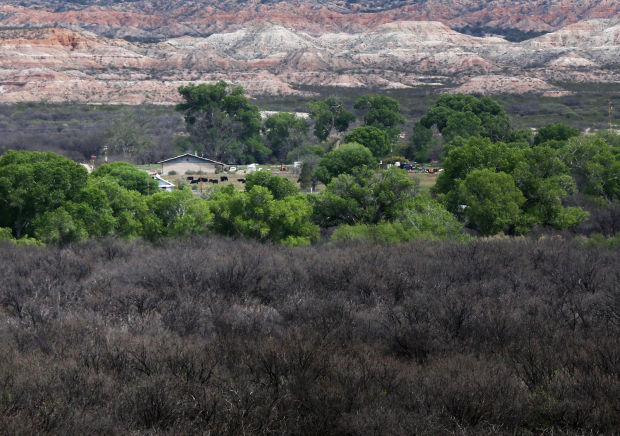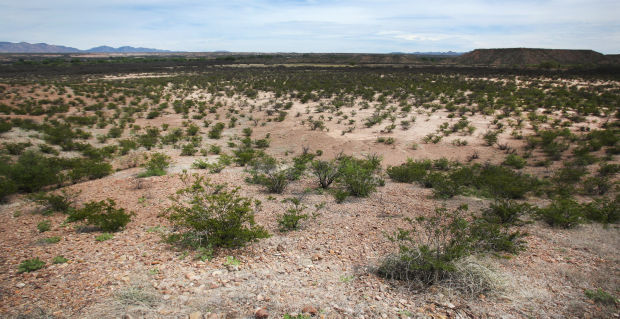Tiny Benson is facing the prospect of a huge development — eight years after a similar proposal crashed with the real estate market.
It’s also facing a big development controversy over whether the project’s groundwater pumping could dry up parts of the San Pedro River.
Phoenix-based El Dorado Holdings, Inc. proposes 28,000 homes as part of a “mixed use” development on 12,324 acres along Arizona 90, about two miles south of Interstate 10 and four miles southwest of Benson’s downtown. Three big votes on the Villages at Vigneto are expected in the coming month at meetings of the city Planning and Zoning Commission and the City Council.
The project, which had its preliminary development plan unveiled last month, gets generally favorable reviews from Benson officials, who hope it will bring more jobs and tax revenues.
The developer — whose chairman, Mike Ingram, is an owner of the Arizona Diamondbacks — says the project is inspired by the Tuscany hill country of central and northern Italy and by “its unique location, impressive array of cultural, social and recreational amenities and natural landscape.” The project’s master plan talks of using “iconic towers” as architectural amenities and offers schools, lots of open space and trails.
Environmentalists are concerned, however, that pumping for so many homes will dry up parts of the San Pedro River, including the nearby St. David Cienega, the only marshland left in the river’s federally protected conservation area running 40 miles south from Benson. The river lies four miles east of the project site, and contains ecologically significant swaths of green upstream and downstream of Benson.
City officials say the project’s pumps will go so deep — 1,100 feet — that they won’t affect the aquifer near the surface serving the river. University of Arizona researcher Thomas Maddock and U.S. Geological Survey hydrologist Bruce Gungle, however, say the clay layers separating various aquifers there will slow, not stop, the environmental impacts.
It’s not known yet whether the federal Bureau of Land Management will step in as it has over the 6,900-home Tribute development planned for Sierra Vista that it’s challenging in court. As stewards of the conservation area, BLM will certainly look carefully at the project, but it’s too early to take a position on it because the bureau only just learned of it, BLM spokesman Adam Milnor said Friday.
If the project is approved, it stands a better chance of surviving than the star-crossed Whetstone Ranch, says Benson City Manager Bill Stephens. Covering the same ground as this project, Whetstone Ranch was to include a Southern Arizona version of Anthem, the big Pulte Homes community that has been a landmark in the northern Phoenix suburb of New River since about 2000.
Eight years ago this month, Pulte abandoned the Benson project just as the real estate market crashed. It would have added 30,000 residents on 6,000 acres of Whetstone Ranch. Only a smattering of homes were built in Whetstone Ranch — in smaller, custom developments outside Anthem’s boundaries. The Villages at Vigneto, covering the entire Whetstone property, would bring more than 40,000 newcomers to the Benson area, where the population is now about 5,100.
“This project has a better chance because we’ve been through the economic downturn and all indicators are that the economy is turning up,” Stephens said. “And it’s not rapid, unchecked, economic improvement. It’s slowly rising.”
Jim Marian, a longtime Tucson commercial real estate broker, said the project could succeed in the near future by offering “a destination retirement community” in the fashion of SaddleBrooke in Pinal County. There’s little demand for new standard tract housing now, he said, but the new SaddleBrooke Ranch development north of Oracle already has such a high percentage of homes sold that it is among the most successful subdivisions in Southern Arizona.
sweeping vision
El Dorado Holdings officials couldn’t be reached for comment on their project late last week. The company’s preliminary community master plan, however, offers details:
- The development would include a mix of housing, businesses, offices, health-care facilities, some agriculture, parks, schools and at least one golf course. Housing density would be 2.3 homes per acre.
- Commercial areas would have retailers, bars and restaurants, a resort or hotel, banks, day-care centers, offices, drive-thru pharmacies, grocery stores, dry cleaners and movie theaters.
- A network of trails up to 14 to 18 feet wide would run along a gas pipeline route and adjacent to roads. In residential areas, pedestrian trails would connect larger community trails through natural wash corridors. A large community park and several neighborhood parks would be developed.
- The project would have 2,500 acres of natural and human-developed open space, exceeding a city requirement of 1,849 acres for such communities.
- Architecture will be “grandiose Tuscan style vernacular, complete with iconic towers that will act as beacons throughout the valley and will signal the decompression from the busy highway.”
Drivers entering the project would go over a bridge “arched over calming waters,” then pass orchards and vineyards en route to a town center and community lakes, the master plan says. Washes would be left natural. Golf courses would be watered with treated effluent when enough becomes available.
- The plan proposes an elementary school and/or a combined elementary and middle school.
Overall, city officials like the project — in part because it offers what they call a holistic rather than a piecemeal approach, said Stephens and Brad Hamilton, the city’s public works director and city engineer.
“They take a look at the whole community,” Hamilton said. “We get master water and sewer plans, not a piece here or a piece there.”
water worries
Less enthused is Tricia Gerrodette, an activist with the Huachuca Audubon Society in Sierra Vista. She’s spent much of the past three years fighting the Tribute project there — a battle now in the courts over whether it’s legal for the state to consider the impacts of groundwater pumping on the San Pedro.
“Until someone does a real study, we don’t know what the impact, the potential impact, will be on the river,” said Gerrodette, who fears the city’s Planning and Zoning Commission and City Council will rush the project through. While the St. David Cienega is upstream of this development, she’s concerned the project’s “huge wells and huge pumping” will suck the marsh dry.
Benson officials say the project meets state requirements for an adequate, 100-year water supply — and the city has an Arizona Department of Water Resources certificate proving that. The aquifer from which this project would pump is separated by two impermeable clay layers from the aquifer feeding the San Pedro, says the city’s Hamilton and Councilman Jeff Cook.
There’s no such thing as an impermeable clay layer, responds UA researcher Maddock, who started researching the San Pedro near Sierra Vista more than two decades ago. Even a clay layer will slowly let water leak through, and the pumping creates what’s known as a “cone of depression” that sucks river water downward toward wells, Maddock says.
“It’s only going to take water out of the stream,” he said. “It’s just one more straw in the system.”









